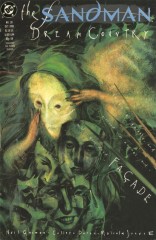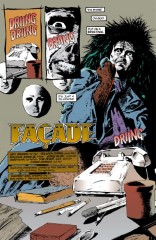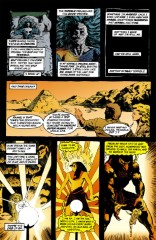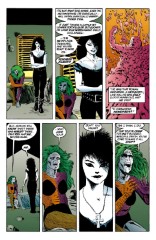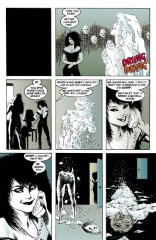Issue 20: "Facade"
Neil Gaiman, Colleen Doran, and Malcolm Jones III
- Fourth story in anthology, Dream Country
- Fourth story reprinted in trade paperback Dream Country
- Audible Act I Chapter 19
Page 1#
The central character of the story is Urania "Rainie" Blackwell, who first appeared in Metamorpho #10 (1967).
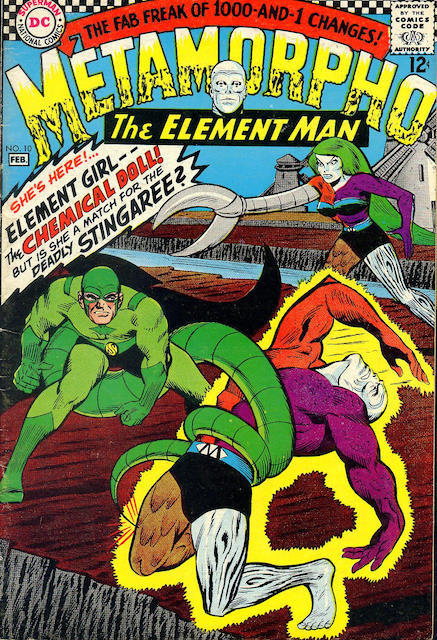
She was an agent with an unnamed US intelligence service who volunteered to expose herself to the radiations of the meteor that formed part of the "Orb of Ra". These radiations had earlier transformed Rex Mason into the superhero Metamorpho. Subsequently, Blackwell took the sobriquet "Element Girl". Both Metamorpho and Element Girl had the ability to transform their bodies into any chemical element or compound found in the human body, and to transform into any shape. As a side effect of their powers, their bodies became non-human in color and composition.
Element Girl had a short career as a superhero, acting as sidekick to Metamorpho, apparently retiring with the first cancellation of Metamorpho's book after 17 issues. Metamorpho lurked around the background of the DC universe for years, eventually joining the Outsiders, then the Justice League.
Her characterization here as a terrified isolated agoraphobe is new.
Page 2#
Panel 1
Mulligan is a new character of little importance beyond this story.
Panel 8
"Company" is a slang term for the Central Intelligence Agency, the chief United States intelligence service. It has been somewhat generalized in fiction to mean any intelligence agency, since authors usually refrain from mentioning the CIA directly.
Page 4#
Panel 3
"Put on a brave face." Also notice all the "masks" in Rainie's apartment. Faces and facades are obviously the theme of the issue.
Page 5#
Panel 2
Della would also appear to be a new character.
Panel 3
Triangle doesn't appear to link back to the original Metamorpho stories.
Panel 5
Leonardo Da Vinci was, of course, a famous Italian Renaissance artist and designer.
Page 6#
Panel 4-5
This is what we have seen before of Rainie's origin.
Panel 6
Ra is an old Egyptian god of the sun, sometimes identified with Amon; he was later replaced as supreme deity by Osiris. He is typically represented as a hawk-headed man.
Page 7#
Panel 1
Apep the serpent is another figure from Egyptian mythology, typically represented as an enemy of Ra.
Page 15#
- This, of course, is good ol' Death, Dream's older sister. Recall that her symbol, the Ankh, is specifically an Egyptian symbol of life.
Page 18#
Panel 8
This is the theme song from the television series M*A*S*H.
The words were never sung on the television show, although they were in the original movie. The panel pictures a shattered facade; we may note that "Shattered Visage" was the name of the graphic novel published by DC that was a sequel to the television series The Prisoner.
Page 19#
Panel 2
Metamorphae: Those who are beyond shape.
Morphogenic: Shape creating.
Metaplasm: That which is beyond being formed. Note that the -morph- morpheme comes from Morpheus ("Shaper"), an appellation for Dream.
Panel 2-3
This appears to refer to events in Metamorpho# 17.
Page 20#
Panel 3
About or before this time, Death appeared in an unauthorized- by-Gaiman crossover with Captain Atom. In that story, this version of Death was described as the incarnation of "death as compassionate release", while other incarnations of death (such as the Black Racer and Nekron) were described in other ways. As Death said there, "It's a big concept, there's room for more than one of us." This paragraph may refer back to that appearance; Gaiman was reportedly incensed at the use of the character.
Page 21#
Panel 5
Note the title of the anthology.
Panel 7
Note the gender of Apep.
Page 23#
Panel 3
This issue is all about facades, false faces. Note that Rainie has to look behind the facade of the sun to the face of Ra.
We may note that Rainie's apartment throughout this issue has been grey, box-like, oppressive, in start contrast to Rainie's physical colorfulness. However, once she escapes her apartment, her colors complement and blend with the outside world; her own personality perks up a bit, too.
Page 24#
Panel 4-6
"Be seeing you..." is a line often used in the television series The Prisoner. The "interrogation" of Death across the phone is vaguely reminiscent of the series. The Prisoner also featured a nameless intelligence agency.
Credits
- Originally collated and edited by Greg Morrow.
- Jim W Lai jwtlai@watcgl.waterloo.edu added Prisoner notes and color symbolism.
- Richard Munn updated some references
Last modified by Richard Munn on 2023-08-21 - Fixed some formatting, and improved blockstyle plugin behaviour
[edit this page] [page history]
